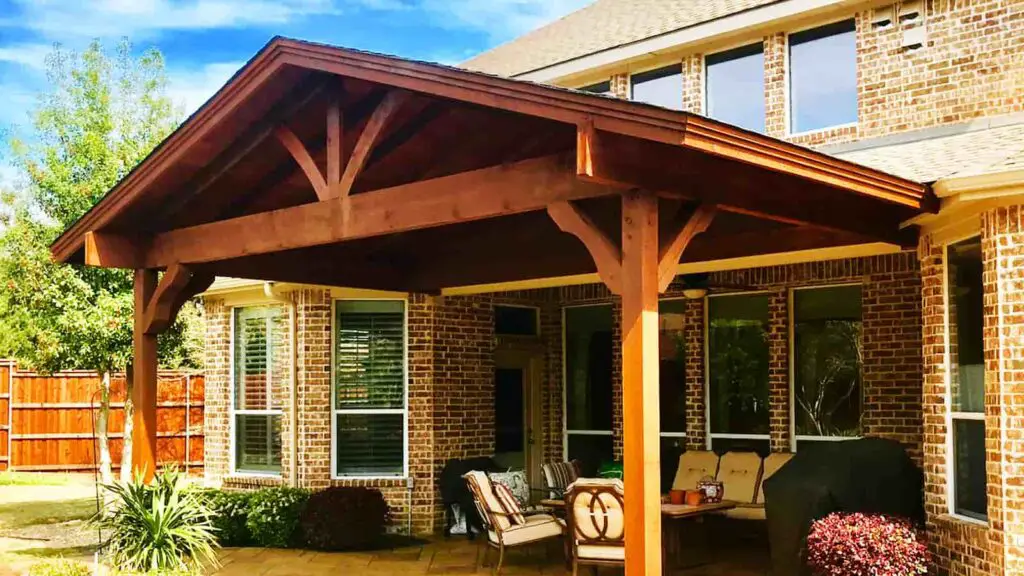
Patio and pergola covers are becoming more popular in the United States. As people become more conscious of their homes, they are installing patio coverings to protect their patios and pergolas from rain and other harsh weather.
There are many benefits to having a patio and pergola cover installed in your home’s outdoor area, but there is also an associated cost.
This blog post will give you some insight into how much it costs to install a patio or pergola covering for your residential property based on factors such as size, material, and region.
Read More: [DIY] Building A Freestanding Patio Cover [10 Ideas]
How Much Do Patio Covers Cost?
So how much do patio covers cost? Well, the average cost per square foot for a Patio Cover or pergola is around $35.15.
Patio Cover Cost
| Type | Size | Cost |
|---|---|---|
| Canvas Patio Covers | 10′ x 10′ | $1346 to $2070 |
| Aluminum Patio Covers | 10′ x 10′ | $2200 to $5020 |
| Wood Patio Covers | 10′ x 10′ | $5507 to $13,500 |
| Vinyl Patio Covers | 10′ x 10′ | $1800 to $4500 |
| 4K Aluminum Patio Covers | 10′ x 10′ | $5089 to $9735 |
Considering there are so many different types of patio covers and pergola systems on the market, one should expect to see a fairly large price difference between them all.
Still, one must understand that our average price reflects over 20 different products and 45 different patio cover/pergola systems from 25 states. This averaged cost also includes (an averaged) installation cost.
Patio and pergola covers protect your patio furniture from the elements such as rain, snow, sun, and wind. It can also provide shade when you don’t need it to be sunny outside.
There are many factors that go into how much a patio or pergola cover costs including the size of the cover, type of material used in construction (e.g., aluminum vs vinyl), and whether they cover only an area for sitting at a table underneath or if there is storage space available in addition to a seating area.
Patios with shading systems attached will cost more than those without additional features because this requires extra materials and labor time to install them properly.
These types of covers may even require special permits before the building process begins so check with local authorities to ensure you are compliant.
Patio Cover Materials
The materials that your patio cover is constructed out of will affect the overall appearance and cost.
Keep in mind that there are other considerations like durability, maintenance requirements, etc., so you’ll want to weigh all of these factors when choosing a material for construction.
Read More: Best Material for Patio Covers: [Comprehensive Guide]
Aluminum, vinyl, wood, fiberglass, and even steel patio cover materials are vastly different from one another.
Up to four times more in some cases (or less). Consider a simple 10-foot-by-10-foot lattice patio cover. This cover can be purchased for as little as $1000 installed in most materials.
To be sure, this type of patio cover is probably from a “big-box” store or an over-the-counter DIY product. But it’s still cheap, right? No, not always.
Still, and for the most part, you should expect to see a wide range of price differences between the various patio cover materials.
Aluminum is more expensive than wood, and steel is more expensive than wood. Of all the materials used to build patio covers and pergolas, I’d have to say that aluminum covers are the most cost-effective.
These products are manufactured by companies such as 4K and Alumawood. Overall, you’ll notice that the distinctions come down to two key factors: materials and installation.
Cover Type
Patio covers on the market today range from simple canvas awnings to more elaborate wooden lattice-style structures. Awnings are frequently less expensive than patio covers.
A patio cover can be attached to the house as a lean-to or as a freestanding structure. The structure and material (wood, vinyl, aluminum, etc.) you choose will invariably play a significant role in the overall cost of a patio cover.
Size
If you have a large patio, it may be tempting to protect the entire area from the elements. You may also want to extend the roof beyond the patio’s edges to provide additional protection from rain and sun. These are all valid desires, but they come at a higher price.
A larger patio cover requires not only more materials, but also more advanced engineering to support larger spans. As you plan for larger spans, the materials you use change.
A solid wood beam, for example, may have covered one distance, but you may now require metal beams to span a larger space.
Patio Cover Installation
Patio cover installation has a significant impact on the overall cost of your project. As an example, we previously mentioned the DIY patio cover.
Many of these low-cost DIY cover manufacturers fail to explain the importance of even basic construction knowledge.
For example, how to measure… use a drill or square an area. We’re not all professional contractors, so it stands to reason that many of us have no idea how to “square an area” for your cover.
This is where you will ensure that your patio cover or pergola’s footprint is at a 90-degree angle from your house. Unless, of course, it is not intended to be.
Open Lattice Vs Enclosed Covered Patio Cover
Traditionally, there is no “one-size-fits-all” solution when deciding between covered and lattice patio covers. In Los Angeles, for example, when deciding between an open lattice cover and a covered type patio cover… The weather could be a deciding factor for you.
Because Los Angeles has a relatively mild climate year-round, a lattice cover could be an excellent choice.
On the contrary, if you live in Los Angeles and are looking for a patio cover, as many of us in the Los Angeles area, entertaining may be the reason for the purchase. As a result, a covered patio may be exactly what you require.
Covered patio covers, by coincidence, make better use of space in all climates. The covered patio is probably the most useful and versatile, especially with the addition of heaters in the winter and misters in the summer.
Different Types Of Patio And Pergola Covers
There are many different types of patio and pergola covers that can be used to protect your outdoor space. You may not even realize the wide range of options available, so it’s important for you to know what they are in order to choose wisely when choosing a cover for your own structure.
Below is an explanation about some common types of patio and pergola covers and costs that homeowners have been using and installed.
Retractable Style Canvas Patio Covers
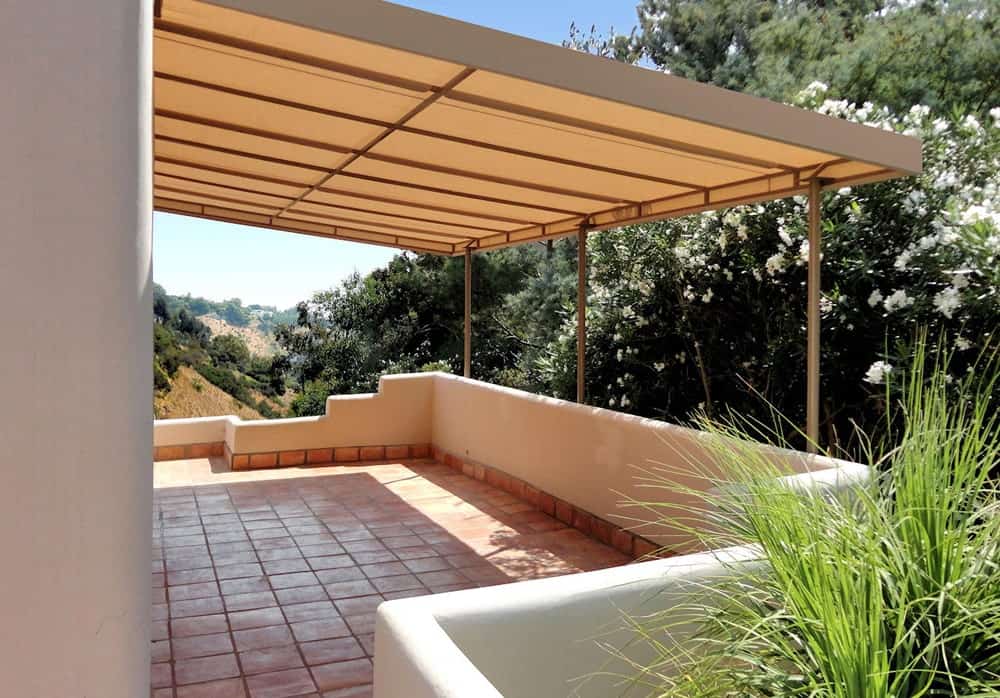
11′ 4″ x 10′ Retractable style canvas patio covers: Average cost: $2071, Price Range: $1346 – $2796
Retractable patio covers are often referred to as Tilt-Tool, Retractable Roofs or Retractable Canvas Covers.
These types of retractables can be left open for hours in the sun, with no damage whatsoever to your rooftop canvas cover. The fabric used is UV resistant and made from a strong Polyester material that will never tear even with direct sunlight exposure over extended periods of time.
This style of the canopy has been designed specifically for commercial buildings where security & protection against vandalism is required by law enforcement agencies worldwide.
They also provide privacy when needed allowing you to leave them open during night times without worrying about anyone looking up at your building’s rooftop covering system while more permanent type metal roofs are closed.
Pros
- Offers shade when desired
- Beautiful sunbrella fabric colors
- Offers great resale value
- Materials are lightweight and manageable
- Engineering supplied
- Is Affordable
- Manual or mechanical available
- It’s Easy to permit
Cons
- Easily soiled
- Some HOAs will not allow materials to be installed
- Looks like a “kit” system
- Be careful when cutting this material. One wrong cut and you need a new piece.
- Great warranty
Aluminum Patio Covers
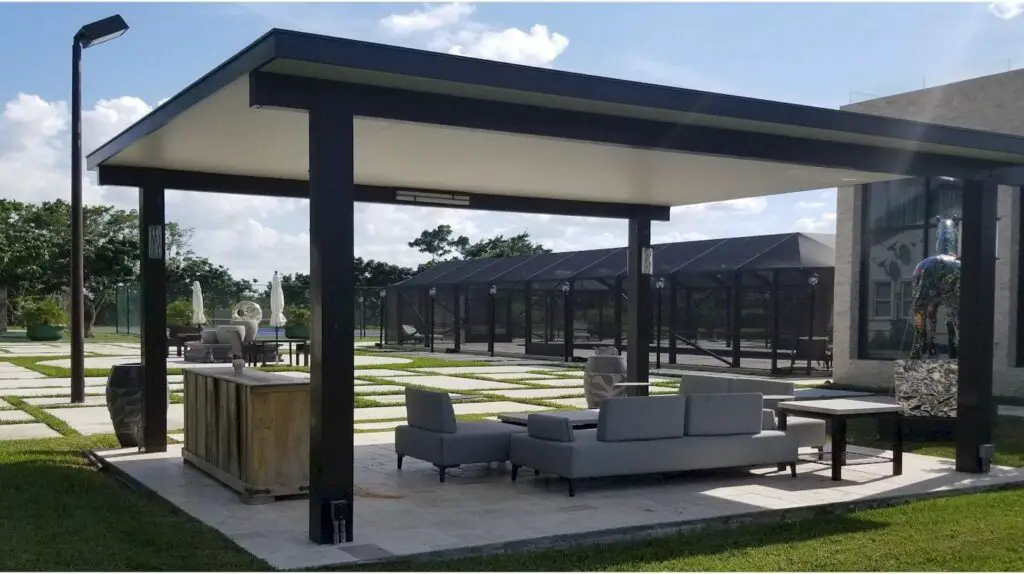
- lattice patio covers 10′ x 10′ : Average cost: $2000, Price Range: $2200 – $3389
- Insulated roof patio covers 10′ x 10′ : Average cost: $5257, Price Range: $4608 – $5907
- Non-Insulated roof patio covers 10′ x 10′ : Average cost: $3611, Price Range: $3609 – $5020
Aluminum patio covers are constructed of aluminum and usually come with a white powder coat paint finish. They will never rust or corrode, making them an excellent long-term option for your pergola cover needs.
Aluminum is lightweight but strong enough to hold the roof up over time without sagging or bending due to weather conditions such as rain and snowfall.
Because aluminum is a low-cost material, it has been a popular choice for patio covers for decades. It is also a versatile material.
Patio covers made of alumawood, such as those found on patiocovered.com, have a distinct wood grain pattern. It’s like having the best of both worlds. You get the look of wood but at a much lower cost than wood or vinyl.
Price isn’t the only benefit. Aluminum patio covers do not rot, crack, rust, or become a food source for termites.
You can also customize Alumawood covers to meet your specific needs and preferences. One can choose between the ever-popular lattice covers, an un-insulated roof, or their 3′′ thick high-density foam insulated roofing system.
The total cost varies depending on the style, system, and “kit.”
Even the most inexperienced DIYer can put these covers together. When purchased as a kit, the covers include all of the parts needed for a complete installation, minus the tools, of course.
Overall, the installation time for an aluminum lattice cover, say 10×10, for a DIYer is likely to be 8 hours with some assistance.
Lattice patio covers
Non Insulated patio covers
Insulated patio covers
Pros
- Will not rot or deteriorate
- Looks like real wood
- Never requires painting
- Lightweight easy to handle and install
- Many colors and styles to choose from
- Lights and ceiling fan compatible
- Great for resale
- Pre-Engineered
- Affordable
- Easy to permit and pass
Cons
- Easily damaged
- Some HOAs will not allow aluminum to be installed
- Looks like a “kit” patio cover
- Be careful when cutting this material. One wrong cut and you need a new piece.
- Paint has a gloss to it
Wood Patio Covers And Pergolas
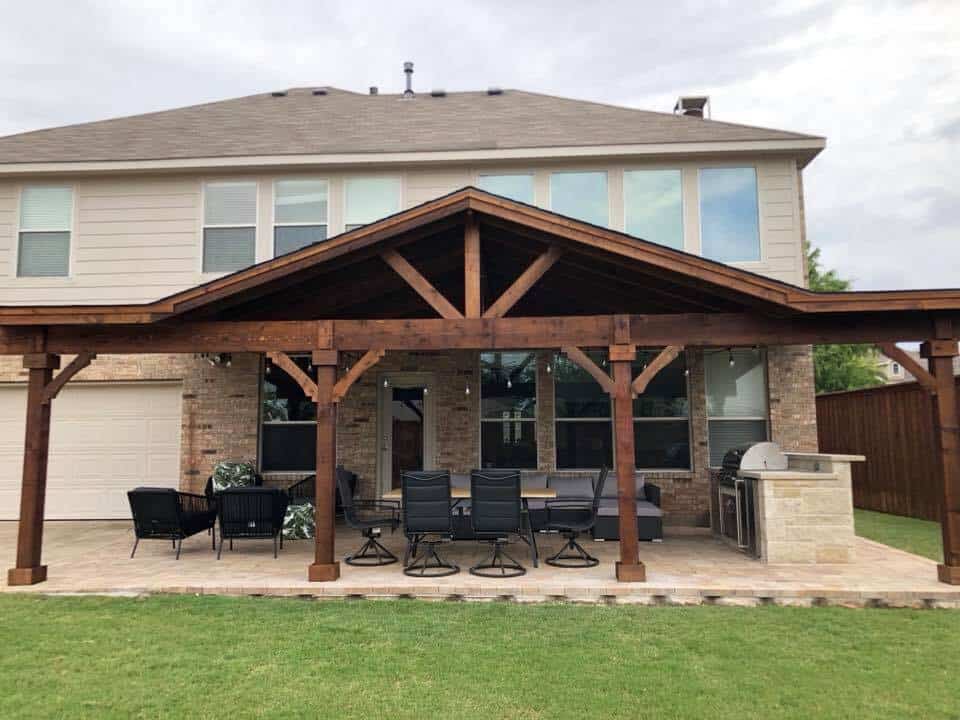
- Wooden lattice patio covers 10′ x 10′ : Average cost: $7193, Price Range: $5507 – $8878
- Wood roof patio covers 10′ x 10′ : Average cost: $10500, Price Range: $7500 – $13500
Wood patio covers are the most expensive patio cover option. We could write an entire article just about the various woods you can use to build your cover and how much of your retirement savings you’d spend on it.
To keep things simple, we’ll only look at the wood species that is most commonly used in Southern California, Douglas Fir. It is, in fact, the industry standard.
Why? Douglas fir outperforms other North American softwoods in terms of strength and durability. That is, it is resistant to the high winds, earthquakes, and storms that we experience in California.
It also has a gold-orange color that many people find appealing. At the same time, Douglas Fir has good fungus and insect resistance. When choosing a material for exterior applications, it is essentially the wood that other woods are compared to.
Building a wooden patio cover necessitates the use of special drawings, and all covers are subject to concrete footings. In contrast to aluminum and vinyl, which are installed directly on a concrete slab.
After an inspection, the wood patio covers must have a hole dug and then filled with concrete. patio cover price
The wood needed for these patio covers varies greatly in size and dimension, which, of course, affects the price significantly.
A single Douglas Fir FOHC wood member, for example, a 6 x 8 x 16, can cost up to $275 per piece. An aluminum rafter, on the other hand, may cost around $30.
Wooden lattice patio covers
Wood roofed patio covers
Pros
- There’s nothing more beautiful added to the exterior of a house than a wood patio cover.
- You can build it to match your house’s finished and or roofing.
- Wood is easy to work with. Unlike aluminum or vinyl, you can patch wood.
- Fantastic for resale
- Easy to install and design
Cons
- Deteriorates easily
- Very Heavy
- Termites love wood
- Requires regular paint or staining ($2200 Every other year)
- Expensive
- Expensive (in case you didn’t see the first one)
Vinyl Patio Covers
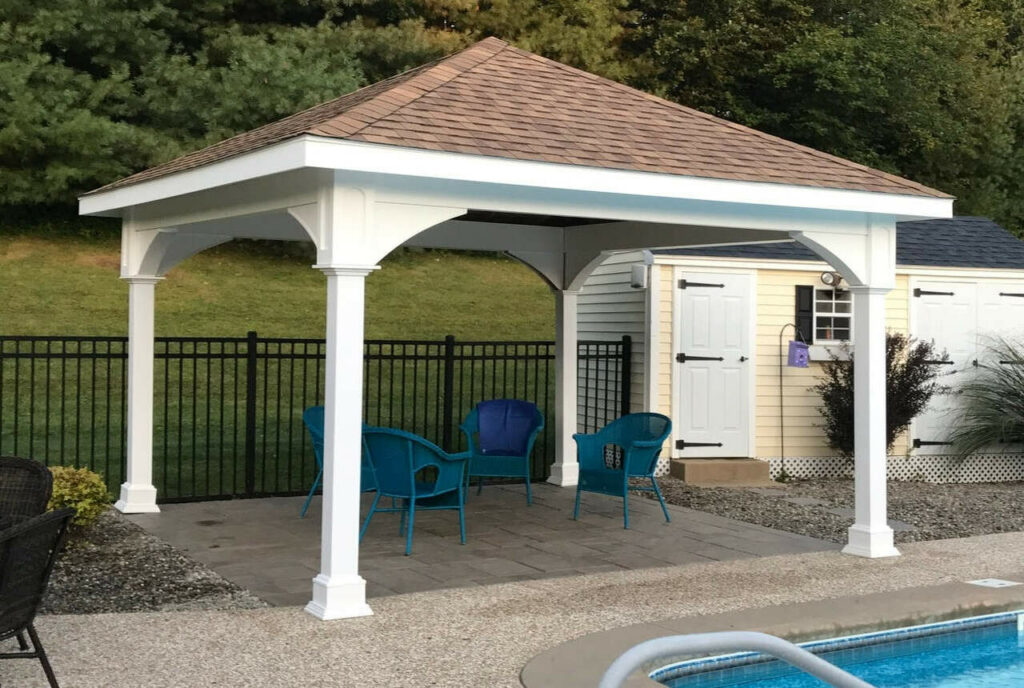
- Solid roofed Vinyl-clad patio covers 10′ x 10′ : Average cost: $3050, Price Range: $1800 – $4300
- Lattice patio covers Vinyl-clad 10′ x 10′ : Average cost: $3275, Price Range: $2200 – $4350
- “DIY” Vinyl kit lattice patio covers 10′ x 10′ : Average cost: $2095, Price Range: $989 – $3200
Vinyl patio covers fall somewhere between aluminum and wood. The vinyl is made of PVC, which has a wide range of applications.
Here are a few unless facts to chew on… PVC is most well-known for its use in plumbing, accounting for 75% of all plumbing pipes worldwide. It can also be found in electrical piping, flooring, and even clothing.
It is found in a variety of healthcare products, including surgical gloves and oxygen masks.
Vinyl patio covers are resistant to common wood problems like rot, warping, and insect infestation. They do not rust, fade, or crack either.
Some vinyl, on the other hand, has been known to turn a yellowish color. Nonetheless, vinyl appears to share many of the same properties as aluminum.
So, what’s the deal with vinyl being sandwiched between wood and aluminum? The price point is higher than that of aluminum while also approaching that of wood. When surrounded by wood or aluminum, it’s basically the worst of all worlds.
So, what distinguishes vinyl patio covers from aluminum patio covers? To begin with, there is more of it, which means there is more product.
While aluminum, like wood, can be used as a stand-alone product, vinyl requires additional steel members to be inserted within each structural piece for stability.
These extra pieces add up to more…, more labor, and more materials. Aluminum, like wood, does not require any additional pieces for structural stability.
Vinyl lattice patio covers
Vinyl solid roof patio covers
Pros
- Doesn’t rot or deteriorate
- Doesn’t require paint
- Lights and ceiling fan compatible
- Lightweight easy to handle and install
- Various colors to choose from
- (Moderately) easily damaged
Cons
- Tends to yellow
- Smooth finish, no wood-like texture
- Looks like a “kit” patio cover
- Be careful when cutting this material. One wrong cut and you need a new piece.
- Engineering or drawings may be necessary under specific conditions
- Some HOAs will not allow Vinyl to be installed
4K Aluminum Patio Covers
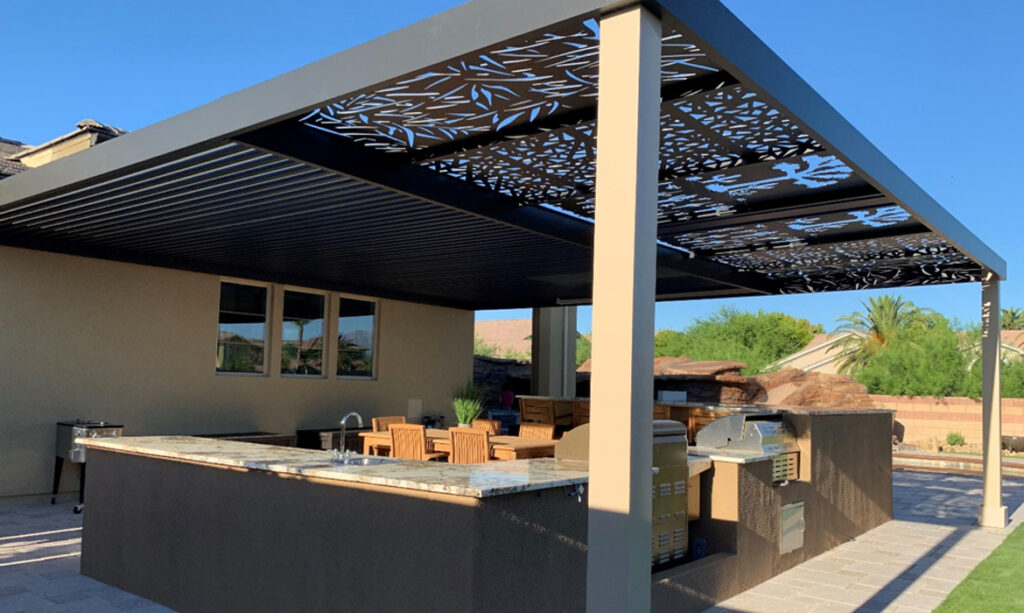
- Lattice patio covers 10′ x 10′ 4K – Aluminum: Average cost: $5840, Price Range: $5089 – $6591
- Soleil® patio covers 10′ x 10′ 4K – Aluminum : Average cost: $8929, Price Range: $8124 – $9735
The 4K Aluminum patio cover and pergola systems are made of heavy-gauge aluminum and are extremely durable.
The differences between this and other aluminum patio cover systems, such as Duraloom, Alumawood, and Fourseasons products, are quite noticeable. Even at its most basic level, the 4K aluminum material is three times thicker than that of the other companies.
Furthermore, the cost difference between the 4K and the other companies is quite small in comparison. 4K aluminum patio covers are available in four (4) different colors.
The powder coat used is a Jotum material, but before the powder coat is applied, the aluminum will be pre-treated with a coat of Gold Chromate. Unlike other aluminum patio cover manufacturers, 4K uses this material as a corrosion inhibitor even on the inside of each part, where you wouldn’t expect to see it.
That is only one feature of this material that elevates it from the “Mercedes Benz” of aluminum patio covers to the “Rolls Royce”.
So, before we ask ourselves “how much do patio covers cost,” we must first consider what the qualities of each patio cover being compared here are.
4K lattice patio covers
4K Soleil® patio covers
Pros
- Very high-end aluminum product
- Extremely thick material compared to Alumawood or Duralum
- Matt finish paint – Jotun powder coating
- Extruded material not rolled formed
- Chemical resistant
- Heat resistant
- Corrosion-resistant
- Humidity resistant
- Scratch and mar resistant
- Impact-resistant (Paint)
- Gold chromate plated
Cons
- Cost more than Alumawood or Duralum
- Some HOAs will not allow aluminum to be installed
- Careful when cutting this material. One wrong cut and you need a new piece
How To Choose A Patio Or Pergola Cover
A patio or pergola cover is the perfect way to protect your investment in an outdoor space.
Patio covers can be purchased pre-built, but many homeowners prefer to have them custom built.
Here are some things to consider when choosing a covering for your patio:
- Choose a size big enough for all of your furniture, but not too large where there’s wasted space.
- Make sure the roof pitch allows water runoff so rain won’t pool on top of the cover while still providing protection from sun exposure.
As mentioned previously, if you already have a covered area choose something that fits your existing structure.
- Consider the color of your covering to match your outdoor furniture and house paint colors. Also keep in mind that brighter colors will heat up faster, if you’re looking for some shade during summer months.
- Make sure there is adequate ventilation so humidity levels don’t build up under your patio cover which can lead to mold growth or insect infestation problems.
- If applicable make allowance for doors or windows on the patio cover itself or within close proximity (doors would be used only when entering/exiting). Same goes with electrical outlets (for fans).
- Keep in mind that these features are not required but may come in handy at times! ~~~ Lastly consider things like decorative columns or trim to add a decorative flair.
- Finally, think about the aesthetics of your patio cover and if it will blend in with your yard or house. Will guests be able to tell what is underneath the roof from atop the ground?
What Is The Cheapest Way To Cover A Patio?
When the concept of a patio was first proposed, it was intended solely for relaxation. You can decorate them and create a relaxing sitting area for yourself, your friends, and family.
Nothing goes too far with concrete patios because they are typically found in the backyard rather than the front yard. Because the only people who will see it are those you invite, why not have some fun?
When brainstorming ideas for how your concrete patio will look, keep functionality in mind. There should be enough seating, which should be all outdoor furniture; a table or some type of surface for food and drinks; easy access to the door leading inside your house; and, most importantly, a cover to provide shade and privacy.
Cheapest Way To Cover A Patio
- Purchase a shade sail or shade cloth
- Purchase a wood frame with a translucent cover
- Construct a Palapa
1. Purchase a shade sail or shade cloth
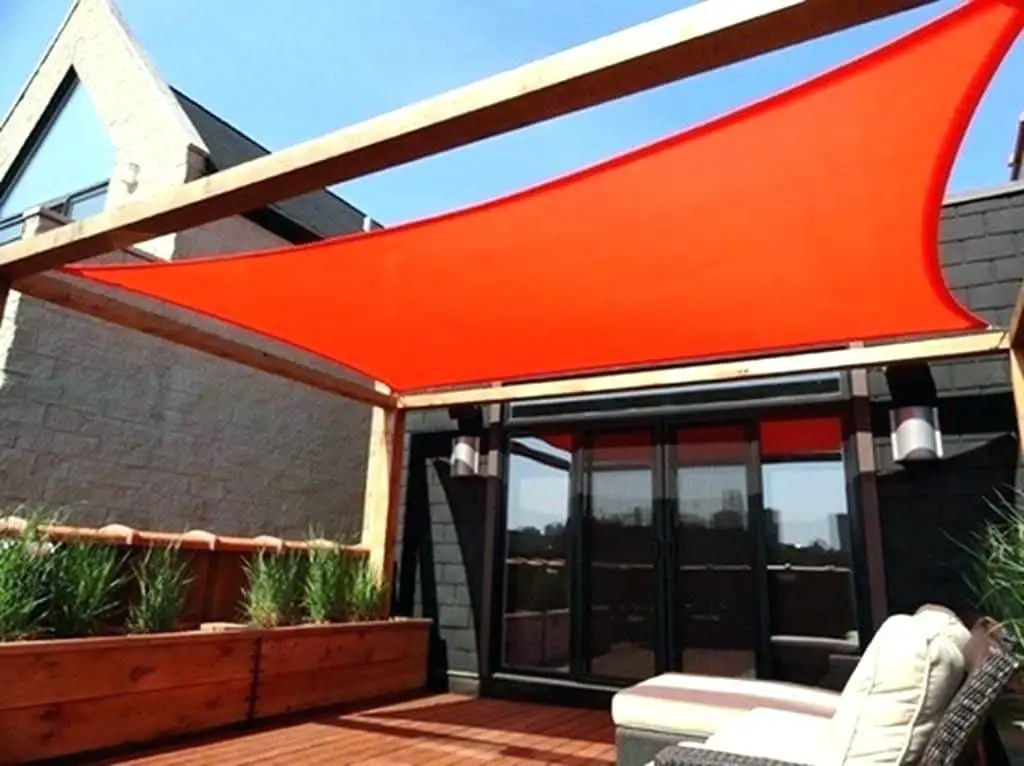
Shade cloth is a stretched piece of fabric that hangs above a patio of any size.
A shade sail is similar, but it is shaped like a sail rather than a square. This may sound similar to retractable covers you’ve seen, but they are not the same.
Shade cloths appear more sophisticated and design-oriented because they are stretched across. They can be placed almost anywhere.
All you have to do is make three or four mounting points for the cloth, depending on its shape. This can be accomplished by burying poles in the ground or by attaching hooks to an existing cover.
2. Wood Frame With a Translucent Cover
Patio covers made entirely of wood with wooden slats running the length of a concrete patio are simply too expensive to manufacture.
They also necessitate a significant amount of time and planning, as well as possibly the assistance of a professional. As a result, instead of building the entire patio cover out of wood, construct only the base frame and then add a polygonal translucent ribbed panel on top for weather protection.
Because of its durability, the type of translucent panel we’re talking about is sometimes used to build greenhouses. It will also do an excellent job of insulating the area covered.
It is typically used in warm climates, but it works well in all climates.
It’s a quick and simple procedure. Build vertical supports out of wood (or other material of your choice) with wooden planks in between.
Lay a few more across the middle to help support the plastic panel that will go over the top. Then you just need to get some help pushing the panel up onto the support beams, attach it, and you’re done! You’ve finished covering your patio!
3. Construct a Palapa
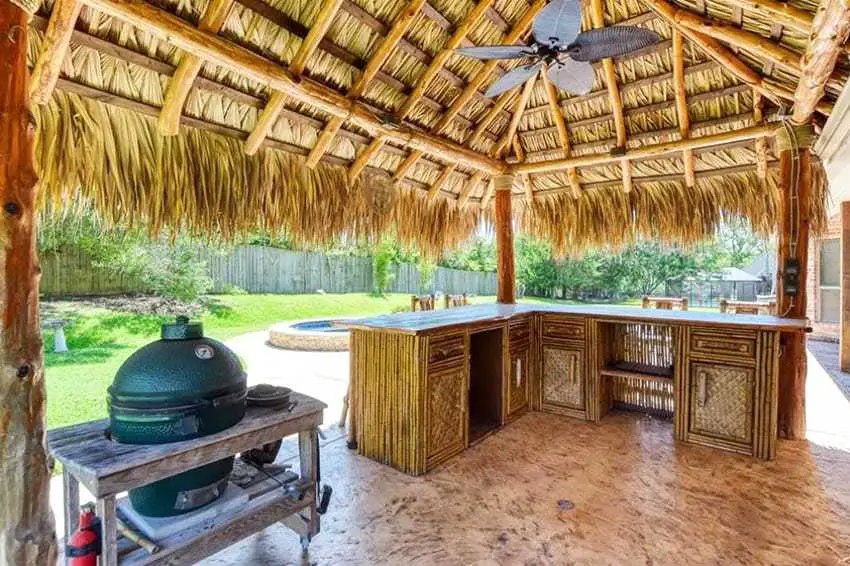
A palapa is a canopy-like structure with a thatched roof. Dried palm leaves are used to make thatched roofs.
You may have seen a palapa over a tiki bar before; you just didn’t know what it was called. We bet you never considered using it to cover your concrete patio on the cheap.
Thatched roofs do an excellent job of keeping the elements at bay and providing plenty of shade. They’re also very interesting to look at.
If you want to design your outdoor space with a beach theme, this could be a good option. Because of the light tan color of the leaves, desert themes may also work.
Palapas are designed for use in warm or hot weather. They can withstand extreme heat, but if a blizzard hits, you’ll most likely have to rebuild the entire structure.
The whole point of building a low-cost patio cover is to save money, so if you live in a cold climate, consider one of the other two options discussed above in this article instead of building a palapa.
Does A Covered Patio Increase Home Value?
Yes, a covered patio does increase home value. A study by the National Association of Realtors found that a garden or covered patios are one of the most popular features for buyers to look at in their new homes.
A covered patio may be one of the least expensive ways to increase your home’s value. It is also an exterior improvement that can easily add curb appeal to your home without having to spend tons of money on renovation or construction costs.
If you are considering adding a new outdoor living space, keep in mind what you want from it before beginning any plans for this project.
There are several options when it comes to planning out and building up a coved patio, but not all will bring about the added benefit of increasing your home’s resale value as well as making them desirable features that future buyers might seek after seeing during their initial tour of the property.
Resources:

![What Gravel To Use For Patio Base [Best Options]](https://www.cleverpatio.com/wp-content/uploads/2021/11/What-Gravel-To-Use-For-Patio-Base-270x180.jpg)
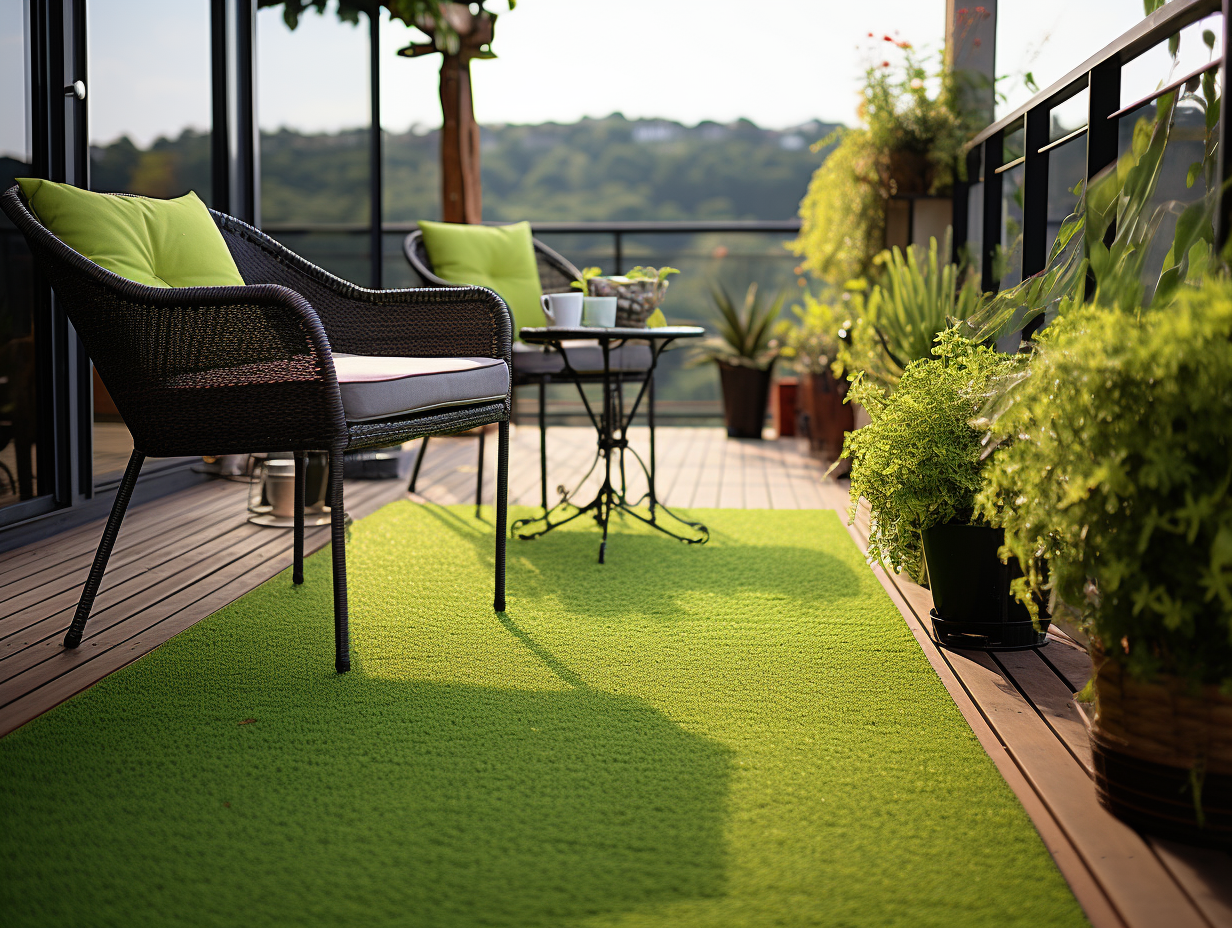
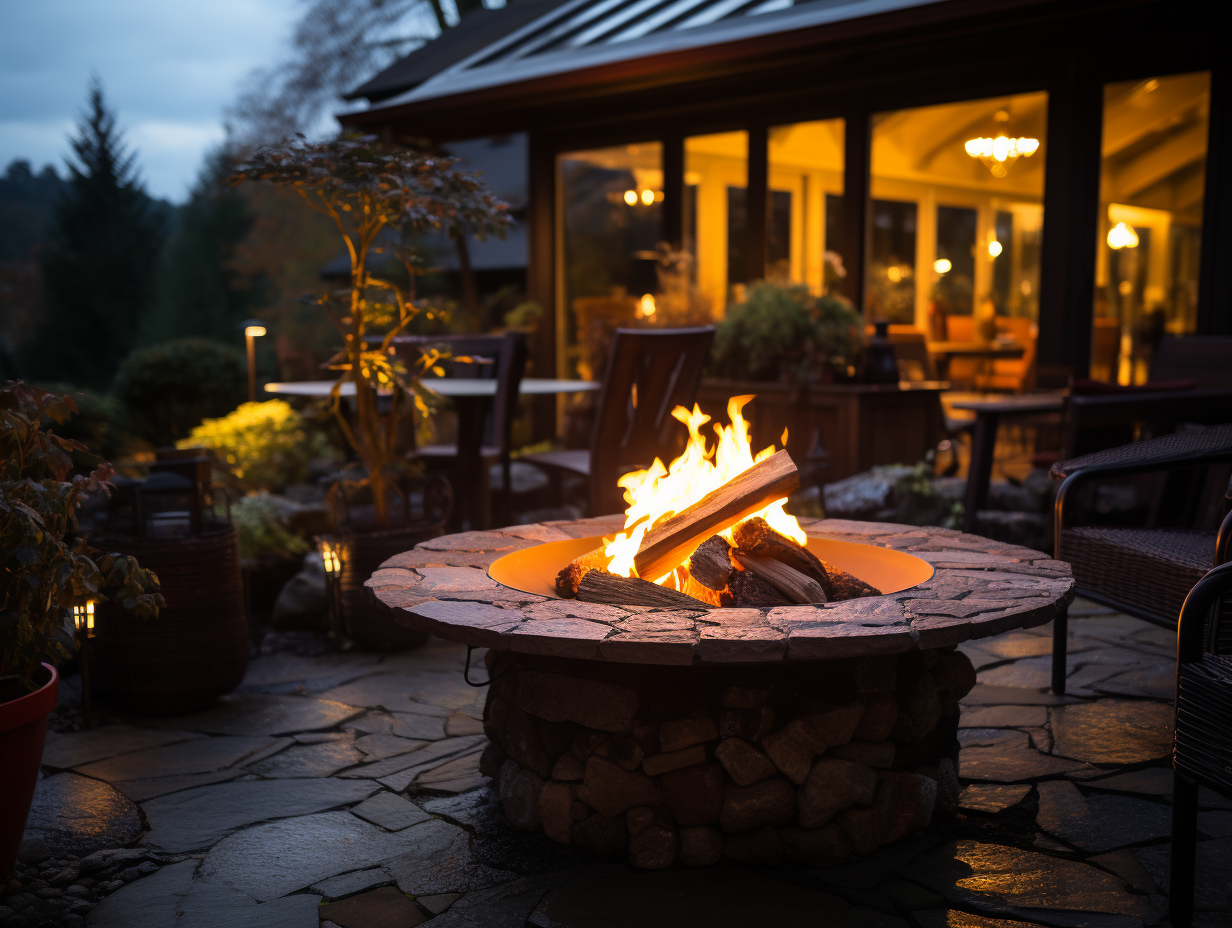
Leave a Reply